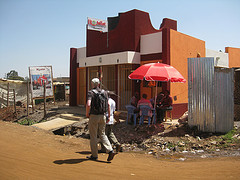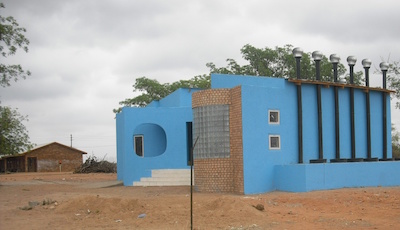Sanitation as a Business
This article is based on a factsheet that discusses the role of different players in the sanitation sector, such as private businesses, governmental institutions and the non-profit sector with a focus on developing countries. Several project examples illustrate activities that can create revenues for investors and local entrepreneurs but also highlight some of the challenges in delivering sustainable sanitation services to the poor. This is intended for entrepreneurs, policy-makers, researchers and programme managers.
Contents
The key messages of this factsheet are:
- Experiences worldwide show that sanitation can be a viable business opportunity, and has the potential to provide multiple benefits to the poor. Market-based approaches seek to address the challenges of financial sustainability and to strengthen the role of the private business sector while empowering local communities and individuals to make their own informed decisions about obtaining sanitation products and services.
- The challenge is still to identify effective, scalable, and sustainable sanitation solutions with economic potential and to allocate investment capital and funding to implement these solutions on a large scale.
- The process of identifying these solutions needs to be a collaborative effort between experts in marketing, design and engineering, which can be effectively supported by national and local governmental agencies as well as NGOs with in-depth local knowledge.
1. Introduction
Considering the sanitation sector as a marketplace full of business opportunities, is not a new concept. The private sector – be it internationally operating large scale enterprises, social entrepreneurial programmes or small and micro-scale businesses of masons, plumbers, cleaners, emptiers or wholesalers – has often been ignored as a reliable alternative or addition to public service providers in the sanitation sector. As a result, particularly developing countries face major challenges in the delivery of safe sanitation products and services, which impacts most heavily on the economically poorer inhabitants.
In 2005 the paradigm shift from beneficiary to “potential costumer” was backed by the publication “The Fortune at the Bottom of the Pyramid” (Prahalad, 2005), which identified the base of the world’s economic pyramid that includes four billion people living on EUR 5.50 or less a day as a market. Prahalad (2005) analysed the spending potential of the world's poor as consumers and the power of business models to generate income and sustainable solutions to alleviate poverty at the bottom of the pyramid (BOP). Hammond et al. (2007) argue that the BOP constitutes a EUR 3.5 trillion global consumer market which reveals “significant opportunities for more inclusive market-based approaches that can better meet the needs of those in the BOP, increase their productivity and incomes, and empower their entry into the formal economy” (Hammond et al., 2007). Based on this context, there is now a growing willingness of all actors in the sector (such as national and local governmental agencies, NGOs, service providers and private sector organisations) to search for innovative approaches to promote, finance and support business models for sustainable sanitation.
2. Market-based approaches
Market-based approaches to sanitation seek to address the challenge of financial sustainability, while empowering a local community and individuals to make their own decisions about obtaining sanitation products and services and strengthening the role of the local private sector. Sanitation is then seen as a vehicle for businesses to provide services and earn revenues that can be reinvested to keep expanding coverage of sanitation facilities and to develop economic activity while improving peoples’ living conditions.
The most effective anti-poverty measures are those that create sustainable and self-perpetuating local jobs. This could for instance be achieved by targeted investments in the sanitation sector in developing countries involving social entrepreneurs connecting investors with micro-entrepreneurs to serve the local market’s sanitation needs.
Social franchising approaches are promising in terms of replication and scaling-up. In a franchising system, entrepreneurs with a suitable profile are identified and receive further training and capacity building in various areas, such as business development, marketing, financing, stock management and technical skills. In order to take the "sanitation as a business model (Devine, 2010) (Sim, Groeber, Greenlee, 2010) to the next level, a combined and coordinated effort from several entrepreneurs working together is needed.Essential to this approach is to consider the economic base of the pyramid. The BOP does not only include the very poor (those living on under EUR 1 per day, for which most likely only subsidised sanitation products realistically can provide sanitation as an alternative to open defecation or unsafe basic facilities) but also those people that have an income of up to EUR 5.68 a day (UNDP, 2008). Millions of people in the BOP – especially in urban settings – are already consumers of items that can be classified as “non-essential” items, such as mobile phones, which illustrates that the poor do have purchasing power to a certain extent. In order to harness the purchasing power of the BOP, sanitation needs to be turned into a demand (Jenkins, 2004). Opportunity means having access to information, products and service, whereas ability refers to necessary resources (financial, time, skills, decision making).
Local governments, sanitation programme managers and other health and sanitation advocates need to provide strong incentives and work with effective sanitation marketing tools to urge individuals to reprioritise their household budgets and include sanitation products and services such as hygiene upgrades on their list of expenses. When working with the lowest income groups, social entrepreneurs, NGOs and governmental agencies need to take into account desirability, affordability and accessibility of sanitation products and services.
3. Who does what in sanitation? Responsibilities of different actors
Collaboration between different public and private actors is crucial within the sanitation sector. The central government’s involvement is important for effective policy-making and funding as well as for setting up agreements with private corporations which then implement appropriate infrastructure. Local governments can play an important part in engaging with small and medium enterprises, NGOs, social entrepreneurs and the civil society.
- In general, governments are most likely to have the mandate and human resources for organising and mobilising communities and awareness raising. However, in certain country contexts with e.g. weak political structures and high rates of corruption it might be more appropriate that other stakeholders like the private sector, NGOs, international agencies or different mass communication media such as newspapers, radio, television or internet play an important role in this process.
- NGOs are mainly financed by public funds, and need partnerships with enterprises in order to carry out projects that have the potential for scale and replication.
- Labour unions may help in complex transitions of national public sanitation bodies or programmes (Heierli, 2004).
Apart from the discussion of who is involved in sanitation, it is of utmost importance not only to look at single components of sanitation but to consider the whole sanitation services chain. The following selection shows different revenue opportunities within the sanitation services’ chain:
- Production of sanitation hardware
- Installation of sanitation systems
- Operation and maintenance
- Promotion and advertisements
- Emptying of toilets and collection and safe disposal of faecal matter
- Training and education
- Reuse of e.g. nutrients, water, organic matter and biogas by e.g. commercial farmers
Examples of sanitation as a business with reference to the revenue opportunities (in brackets) that they include are discussed in the next section.
4. Examples of business approaches
The following examples for sustainable sanitation business approaches were provided mainly by members of the working group. They range from proven large business models. Giving these examples in this factsheet is not meant as a particular „endorsement“ of the business model but primarily as interesting examples on how businesses around sanitation could be set up and about the challenges they face in order to achieve a sustainable system.
|
|
Please see numbered items in sanitation services’ chain above:
- Example for (2), (3) and (4) - Installation, operation, maintenance and advertising: Public toilet management in city areas in Kenya: Since 2007, David Kuria (elected as Ashoka fellow in 2007) has been working with social business models in his social enterprise EcoTact. One of EcoTact’s social business products is the Ikotoilet mall, a community hub of stores and services built around a public toilet complex. People can use the facilities, as well as buy products and services available in the mall, such as shoe shining or barber booths, food stalls, phone and newspaper stands.
- Example for (5) and (7) - Collection of faecal sludge and safe disposal or reuse: On-site sanitation (septic tanks and pit latrines) in cities of developing countries: Encouraging the development of products from excreta and identifying and developing markets for these products will help combat uncontrolled discharge of excreta, which is imperative to achieving public and environmental health objectives. In addition, it will also trigger private enterprise involvement in scaling-up and replication of such approaches (Koné, 2010). Urban-poor households will benefit from these improved business opportunities through lower costs for services, and improved quality and reliability, and availability.
- Examples for (1), (2) and (3): Creating jobs and income with mobile UDDTs (Urine Diversion Dehydrating Toilets) and UDDT business in India: Ecoloove is an interdisciplinary social venture, founded in 2008. Ecoloove was started with th e aim to develop affordable ecological sanitation (eco san) solutions for people in developing countries. A mobile ecosan system (UDDTs) was designed to be run by w omen living in slums in India.
- Examples for (2), (5) and (6): School toilet cleaning and maintenance services, training and hygiene education: In 1996 Trevor Mulaudzi launched “The Clean Shop”, a “clean-up business” for public toilets and school toilets in South African townships. This social enterprise succeeds in making sanitation a business by providing services and changing people’s mindsets about hygiene and cleanliness in public schools and communities.
The examples show that sanitation can be a profitable and viable business opportunity and offers many entry points in the value chain. In these particular examples, business was done by producing and installing sanitation products, providing maintenance or collection services, collecting user fees in public toilets and selling advertisement spaces in toilets and on vehicles. Other examples can be found for businesses in training and education and - possibly - reuse.
5. Outlook
An observation from recent sanitation programmes is that they have been largely implemented by sanitation sector specialists, such as engineers, rather than business and marketing experts (Devine, 2010). This may be one reason that has contributed to the limited successes in scaling up projects to serve the mass market.
Lastly, it has to be emphasised again that the 4 billion people that fall in the Base of the Pyramid income bracket and are suffering from the sanitation crisis need to be viewed as valued customers and a potential market by sanitation businesses.
6. Acknowledgements
SuSanA factsheet: Capacity development for sustainable sanitation. April 2012.susana.org





